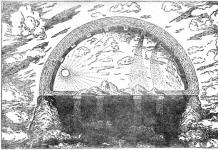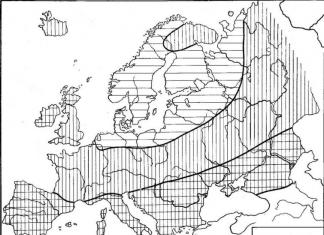which was named comet of the century, entered Earth's orbit and is now visible to the naked eye.
The comet has become significantly brighter over last days, as it approaches the Sun. If it survives its flight, it will be the brightest celestial show in more than 300 years.
Over the next few weeks, the comet will become even brighter until it outshines the Moon.
Comet of the Century 2013
Comet ISON was first spotted by Russian astronomers Vitaly Nevsky And Artem Novichonok by using International Scientific Optical Network(International Scientific Optical Network) in September 2012, when it was 941 million kilometers from the Sun.
A ball of ice and dust came from Oort clouds– a huge accumulation of ice debris left over from the creation solar system, which is located at a distance of 150 trillion kilometers from Earth.
Although other comets, such as Comet Hale-Bopp, are thought to have come from the Oort cloud, Comet ISON will first in 200 years to come close to the Sun, which came from the edge of the solar system.
ISON is moving at a speed of 377 km per second and will come closest to the Sun November 28, 2013, located at a distance of 1.2 million kilometers from the surface of the Sun, and will heat up to 2760 degrees Celsius.
Comet ISON's path around the Sun
If the calculations turn out to be correct, then this galactic show can be compared with the Great Comet of 1680, whose tail reached 150 million kilometers and was visible even during the day, which in those days was considered God's punishment.
Even if Comet ISON disintegrates before then and cannot survive its approach to the Sun, experts say its "death throes" will be no less impressive.
Comet ISON: latest news and images
How bright will Comet ISON be?

Comet ISON C/2012 S1 was photographed by the European Southern Observatory's (ESO) TRAPPIST telescope in Chile on the morning of November 15, 2013.
Scientists suggest that the comet will so bright that it will be visible even during the day.
Astronomers measure the brightness of an object in the night sky in magnitude. The brighter the object, the smaller the magnitude. The human eye is able to perceive dim objects at magnitude +6.5.
The latest observations show that Comet ISON has become significantly brighter in recent days, reaching a magnitude of 5.7 to 6.1.
Amateur astronomers have already begun to observe the comet through small telescopes and binoculars.
Will the Sun Destroy Comet ISON?

Infrared observations from the Spitzer Space Telescope captured the glow of the nucleus and coma of Comet ISON in June 2013
The coming weeks will be crucial for the comet. When she comes close to the Sun, solar radiation can evaporate all the water and other volatile components of the comet. The gravitational influence will also be very strong. Many comets do not survive. A rare exception was Comet Lovejoy December 15, 2011.
If ISON survives its flight close to the Sun, we will be able to watch an amazing show from November 28, 2013, or it may fall apart.
How big is Comet ISON?

Images of the coma and tail of Comet ISON space telescope"Hubble"
Scientists who observed this comet through the Hubble Space Telescope were surprised that its size reached no more than 5-6.5 km in diameter. The comet's head or coma reaches 5,000 km, and the tail is about 90,000 km in length..
Comet ISON in November 2013
When can you see Comet ISON?

It is now passing close to the bright star Spica in the constellation Virgo.
Comet ISON will be best seen outside the city, where there is less light pollution. Clear skies and no moon can also help.
The comet can be observed for the next few days in the wee hours with binoculars.

The location of Comet ISON in the night sky until the end of October 2013
Comet ISON will be visible in November 2013 early morning in the southern sky. Starting in December, if the comet survives its flight close to the Sun, it will likely be visible all night.
On the night of January 14-15, 2014, dust from the comet's tail may result in meteor showers and beautiful noctilucent clouds.
In photographs comet ISON, which were obtained by scientists at the Max Planck Institute and the Wendelstein Observatory, you can see barely noticeable “wings” on the sides extending from the core. It is impossible to notice them with the naked eye. They can only be examined using special equipment and programs for image processing. Scientists make detailed observations of changes occurring with the comet by scanning the gas cloud located around comet ISON.
According to data received from the computer, one fragment has already fallen off from the comet, or several small ones - Benhard's words. November 28 comet ISON will approach the Sun at the closest possible distance, almost 1,000,000 kilometers. This is 150 times closer than that the distance to which it approached, and which is considered one of the brightest comets of the last century. Having warmed up from the Sun, it could be seen with the naked eye for another 18 months.
Comet ISON, approaching the Sun, will begin to accelerate under the influence of gravitational forces to a speed of 380 km per second. And the heat of the star will warm the guest up to a temperature of 2700 degrees, which will ultimately make this comet the brightest of all comets.

Now the comet is at this distance from the Sun, like the planet. In the coming days, it will intersect with the orbit of Mercury and approach the star as close as possible. According to calculations, the peak of proximity to the Sun should take place on November 28, 2013.
The comet is at close range from the Sun, which prevents you from taking good, high-quality images. You can already see it early in the morning above the horizon, while the Sun has not yet risen.

On November 28, when passing at the closest possible distance from the Sun, the comet may explode. Comet ISON was discovered on September 21, 2012 by Russian scientists Nevsky and Novichonok in ISON Observatory, which is in Kislovodsk.
Flying towards the Sun, which may become one of the brightest comets observed in the sky northern hemisphere V last years. Whether the heavenly guest will live up to expectations is still unknown, but interest in her is growing day by day.
This post was created in order to quickly follow news about the comet. It will be updated chronologically as new information becomes available. Other articles about the comet can be found.
This interactive animation shows Comet ISON's path across the sky until mid-January 2014. Use the slider to find out which constellation Comet ISON will be in on any given day. To do this, in the upper leftmost window, select the view of the comet from Earth. (Telescope icon.)
November 30, 2013
Update at 19:00 Moscow time. vr. Comet ISON continues to dim, as seen in the latest SOHO image taken at 18:43 Moscow time:
Comet ISON November 30, 2013 at 18:42 Moscow time (visible below left). Photo: NASA/SOHO
The latest animation of Comet ISON based on photographs from the STEREO-B observatory:

Comet ISON survived both before and after perihelion. Source: NASA/STEREO
Rising from the dust, the comet acquired an unusual double tail, similar to a jackdaw or greek letterγ. The tail lying along the trajectory of ISON obviously consists of dust, the same one that turns away from the Sun is formed by the gas component of the comet - ions of carbon, oxygen, hydrogen and other elements. If so, then cometary nucleus probably still exists . These assumptions are confirmed by scientists.
On the other hand, after appearing from behind the Sun and briefly increasing its brightness to 1 m, the comet began to quickly dim again:

An image of comet ISON taken on November 30, 2013, at 16:18 Moscow time. The comet, visible at the top right of the image, has dimmed again. Photo: NASA/SOHO
This may indicate that the remaining cometary nucleus is very small in size and/or close to final destruction.
November 29, 2013

A processed image of comet ISON taken with SOHO C2 at 17:40 UT (21:40 Moscow time). Photo: Jakub Cerny/SOHO
As we can see, in this combined SOHO image (LASCO C2 and LASCO C3) the head of the comet no longer exists.

Alarming news: the comet's nucleus appears to have ceased activity. A very powerful dust tail (the ion tail is much thinner in the image) may indicate complete destruction of the ISON core. Source: SOHO
As we already wrote, tonight (November 27 at 21:00 UTC), astronomer and expert on near-solar comets Karl Battams determined the brightness of ISON to be -1 m. At 4 am Universal Time, the comet's brightness increased to -2 m! The comet is equal in brilliance to Jupiter! At 13:00 Universal Time (different from Moscow by -4 hours), the comet suddenly began to lose brightness. Has the comet evaporated? We are waiting for news, watching the NASA broadcast (below).

Animation of 123 images of Comet ISON taken between November 26, 21:20 UT - November 28, 15:37 UT. As the comet approaches the sun, it initially rapidly increases in brightness; it even has a horizontal artifact line, indicating great brilliance. But near the Sun, the comet begins to dim. Source: SOHO
Update at 22:20 Moscow time. vr.
Astronomers and specialists are watching and discussing the perihelion passage of comet ISON live. NASA broadcast (in English):
Update at 7:45 Moscow time. vr.
The comet continues to approach the Sun. There are only a few hours left before ISON enters the rarefied but very hot (heated up to a million degrees!) solar corona. Let us remind you that starting from 17:00 Moscow time, behind the comet.
The comet passes perihelion (the point of its orbit closest to the Sun) tonight at 22:25 Moscow time . At this time, the comet will hide behind the protective disk of SOHO and will not be visible for some time (only its tail, unless it is destroyed by a coronal ejection). But at this time, attention, the comet can be monitored on the observatory website S.D.O.(Solar Dynamics Observatory)!
There is no evidence of collapse yet. The story of the drop in brightness observed the other day seems to have received its explanation. This was a temporary drop in activity as the comet was between two outbursts.
Over the past 24 hours, ISON activity has increased significantly. In particular, there was a dramatic increase in brightness of ~3.5m, clearly visible in the latest SOHO images.

Continuing the story with the destruction of the ISON core (see news on November 25 and 26 below). Renowned comet observer Bruce Gary published his observations of the comet on November 26th. The astronomer did not find any evidence in favor of the destruction of the core. However, this may mean that the fragments of the decayed nucleus are moving close to each other, at a smaller distance than the resolution of Gary’s images...
Let us remind you that on November 28 at 22:25 Moscow time, the comet will pass at a distance of 1.16 million km from the surface of the Sun. Whether it is far or close can be seen in the picture below.

Comet ISON is at perihelion, to scale. Drawing: Bruce Betts
As is known, even completely healthy comets often cannot withstand such close approaches to the Sun. Therefore, now cometary astronomers are like doctors gathered in a room over the bedside of a patient. The patient is hung with all sorts of sensors, several cameras monitor his every movement. As a result, doctors are overwhelmed by the abundance of information and are unable to make a diagnosis.
No one wants to lose such a comet - neither amateurs who have binoculars and cameras at the ready, nor professionals whose toys will be more expensive - after all, ISON is the first comet from the Oort cloud that is studied so thoroughly and comprehensively. Looks like it's time to stop wondering whether the patient is alive or dead and just wait for perihelion. It’s best to while away the time until the evening of November 28th (it will already be the 29th somewhere) with SOHO.
Observing Comet ISON November 27-30 using SOHO
Starting today, the comet will be visible on the website of SOHO, the solar telescope that observes our star from space. The ISON telescope enters its field of view around 02:00 UTC on November 27. In Moscow at this time it will be 6 am, in Kyiv 5 am, in Yekaterinburg 8 am, in Krasnoyarsk 10 pm, in Yakutsk - 12 pm.
Photo of comet ISON
The first was made on November 20 by the automatic interplanetary station "Messenger", which is now in orbit of Mercury and is studying this planet in detail.

Comet C/2012 S1 (ISON), image from AMS Messenger. Photo: NASA/Johns Hopkins University Applied Physics Laboratory/Carnegie Institution of Washington/Southwest Research Institute
Actually, what is impressive is not the image (which, without taking into account the capabilities of the device, may seem mediocre), or even the detailed studies of the comet using the probe’s ultraviolet and X-ray spectrographs, but the very fact that dozens of spacecraft are connected to ISON observations. At this rate, ISON may become the most studied comet in human history, surpassing even the famous Halley's comet with the armada of probes that flew past it in 1986...
The second photo we noticed was taken yesterday afternoon. It allegedly depicts Comet ISON. Honestly speaking, determine by appearance the object is quite difficult, but it seems quite plausible that it is a comet. When photographing, the author used a cardboard disk that blocked the Sun. Part of the disk is visible in the photo below left.

November 26, 2013
Is Comet ISON Destroying?
In continuation of yesterday's message (see below) by Michal Dragus about the possible disintegration of the nucleus of comet ISON, Phil Plait, a well-known astronomy popularizer and author of the Bad Astronomy blog, spoke with a message.
Let us recall that observations of the comet during the period November 21-25 in the millimeter range of the spectrum showed a sharp drop in the intensity of light emitted by certain types of molecules (in particular, HCN). At the same time, other experts reported increased dust emissions from the comet's nucleus. This evidence may indicate that the comet is running out of material and its nucleus is disintegrating, as reported by Dragus. However, there is another explanation.
One of them is the uneven distribution of ice and frozen gases over the surface of the comet. In this case, the comet's nucleus remains unharmed and only suspends activity after the exhaustion of volatile substances in one of its parts. If this hypothesis is correct, jets - directed streams of material - are likely to appear later in the ISON coma, indicating that only certain regions of the comet's nucleus are emitting material.
Actually, a similar scenario was observed several years ago with the famous short-period Comet Holmes...
Comets ISON and Encke meet near the Sun
Another update from spacecraft STEREO-A: Comet ISON caught up with Comet Encke. Of course, as we already wrote, comets will not collide with each other or with the Earth (the bright star on the right). All of them are now moving at a distance of tens of millions of kilometers from each other and are only projected side by side in the picture, due to the fact that they are on the same line of sight.

As you can see in the animation, Comet ISON has developed a decent tail and appears significantly larger than Comet Encke. True, it is closer to the solar observatory than the latter. And this video shows the movement of comets ISON and Encke on parallel courses:
Will it be possible to observe Comet ISON at perihelion?
This is the question asked by veteran amateur astronomer Bob King on Universe Today. If the brightness of the comet, King writes, reaches -4 m or higher in the next 2 days (this roughly corresponds to the brightness of Venus), then the comet can be found even in the daytime sky on November 28, when the comet will be a few degrees from the Sun.
Naturally, you cannot look at the sky without precautions: bright sun May damage your eyesight! King suggests using a method that he successfully used in 2007 when searching for Comet McNaught. Namely: close daylight the angle of any stationary object, be it roof gables, church spiers, masts of high-voltage lines, buildings and even... clouds! How sharper angle, the more open space in close proximity to the sun opens up to vision.

An example of how a roof can block the Sun. When using binoculars to search for a comet, make sure that the focus of the instrument is set to infinity and not to the roof, otherwise there will be no chance of seeing the comet. But remember: under no circumstances look at the Sun! Photo: Bob King
It is clear that this is a rather dangerous method. The sun does not stand still and may suddenly appear from behind an object during a search. In this case, the damage done to your retina will be quick and painless. Is it worth losing your precious vision for the sake of a comet?
Well, then you can sit at home in a comfortable environment and watch the passage of Comet ISON past the Sun on the Internet. On the solar observatory website SOHO new photographs are published with high frequency, which will make it possible to observe the comet during November 27-30 almost in real time.
November 25, 2013
Less than 3.5 days remain until perihelion. Comet ISON is already deep inside the orbit of Mercury, and has practically disappeared from earthly observers in the rays of the morning dawn. Currently, the distance from the comet to the Sun is 0.23 AU. e. (34 million km), the speed of the comet relative to the star is 86 km/s.
The end of Comet ISON?
New evidence that Comet ISON is collapsing came today from astronomer Michal Drahus of NRAO. According to him, observations in the millimeter wavelength range at the IRAM telescope (Spain) showed a rapid and significant decrease in the brightness of molecular lines in the comet's spectrum during the period November 21-25. This means that now "the nucleus of Comet ISON is inactive... or no longer exists."
This alarming assumption is consistent with the observations of the famous “comet catcher” Terry Lovejoy, who stated that over the past 2-3 days the brightness of the comet has decreased slightly, instead of increasing. In the STEREO-A images (see below), the comet still looks bright, and this is a problem: the brightness is supposed to be increase rather than staying at the same level...
Astronomy enthusiasts say goodbye to Comet ISON until December
However, astronomy enthusiasts are preparing to welcome Comet ISON in December. In fact, the predictions about the collapse of ISON have not come true twice already... Until ~December 5, comet ISON will be observed only during the day and at space solar observatories. That's why we present to your attention a gallery of the latest images of the comet before perihelion, taken by astronomy enthusiasts around the world.
Comet ISON and the planet Mercury on the morning of November 23. The photo was taken in Nagano (Japan). Photo: Kouji Ohnishi
Comet ISON and its thin tail about 3° long. The photo was taken on November 20 in Georgia (USA). Canon XTi camera, Nikon 50mm lens, 6×6 second exposure, ISO 800. Photo: Bob Lukasik
Comet ISON on its way to the Sun. Photo: NASA/MSFC/Aaron Kingery
Image of comet ISON using the telescope named after. Isaac Newton (Roques de los Muchachos Observatory, Canary Islands, La Palma). Photo: Pete Lawrence
Mercury and Comet ISON. Photo: Rob Ratkowski
The tail of Comet ISON looks like a spotlight. Bright Star on the left is the planet Mercury. The photo was taken in Nagano (Japan). Telescope (Carl Zeiss Apo-Sonnar T* 2/135 mm), F=2.8, Canon EOS5DMkIII camera, ISO1600, exposure 10 seconds. Photo: Kouji Ohnishi
One of the last images of Comet ISON before perihelion. The photo was taken on the morning of November 24 on the island of Tenerife (Canary Islands). Camera Olympus OM-D, F1.1/50 mm, exposure 40 sec, ISO 400. Photo: Fritz Helmut Hemmerich
Will Comet ISON Hit a Solar Storm?
During its perihelion passage, Comet ISON will pass just 1.16 million km from the Sun's surface, less than one star diameter. Such proximity to the Sun, of course, will not pass without a trace for the comet: the surface of its 3-kilometer core will heat up from the flow of heat and light to a temperature of over 2000°. Whether the comet will survive its approach to the Sun, only time will tell.
November 20, 2013. Hubble looks at Comet ISON

Hubble's last look at Comet ISON before perihelion. Photo: NASA/ESA/Hubble Heritage Team (STScI/AURA)
This is the last image taken by the space telescope of Comet ISON before the comet crosses perihelion on November 28. See more details.
November 19, 2013. The FORTIS rocket is ready to observe Comet ISON
As comet ISON approaches the Sun, more and more observatories and scientific organizations are joining its study. On Tuesday, November 19, the FORTIS ballistic missile launched from White Sands Missile Range in New Mexico, carrying equipment to study Comet ISON in ultraviolet light. The rocket is capable of rising to a height of up to 100 km, where observations are not interfered with by the earth's atmosphere; The flight as a whole lasts 15 minutes, and the observation time is about 6 minutes.
The NASA-funded FORTIS (Far-ultraviolet Off Rowland-circle Telescope for Imaging and Spectroscopy) observatory rocket is designed to study distant galaxies. Its first launch took place in May 2013. Now scientists hope to examine in detail the processes of sublimation of ice and gases from the surface of the comet during the next launch. Evaporating, the comet's material quickly ionizes under the influence of solar wind flows and begins to glow like the sky during auroras. This glow makes the main contribution to the brightness of comets near the Sun, including the brightness of Comet ISON, which after its outburst on November 14.

The FORTIS rocket before launch at the White Sands test site. Photo: Stephan McCandliss
The main instrument of the FORTIS observatory is an ultraviolet spectrograph, which should obtain a detailed spectrum of the comet in a few observation minutes. The distribution of energy in the spectrum will tell us about the intensity and rate of ionization of the comet’s matter.
October 21, 2013: Comet ISON shines. Will the comet produce a meteor shower?
Predictions are often a thankless task, especially when it comes to comets. Immediately after its discovery in September 2012, comet ISON was awarded the status comet of the century. However, observations in subsequent months showed that ISON's brightness was not growing as quickly. And now, when the comet has already crossed the orbit of Mars, its brightness is approximately 1.5 m lower than originally expected.
Does this mean the comet will not live up to expectations? Not yet. Recent observations indicate that after perihelion, ISON's maximum brightness could be -2 m - -5 m, meaning the comet would be as bright as Jupiter or even Venus. Currently, the brightness of ISON is 10.0 m and is growing only slightly faster than the brightness of a purely reflective body (such as planets, asteroids, etc.) approaching the Sun.

Light curve of Comet ISON based on data collected up to October 20, 2013. The maximum brightness is predicted in the region of -2 m. Drawing: COBS
Another news: British astronomers answered the question of whether . The answer is clear: can not!
Two faint tails are visible between Comet ISON's green coma and a bright star near the center in this photo taken on November 6, 2013. They may be the beginning of an ion tail. Credit: Damian Peach.
I'm starting to worry about . I can't help her. With virtually every telescope facing the comet, less than three short weeks until perihelion, each week brings new photos and events. The most recent photos show a completely new tail feature emerging from the comet's bulging coma. For months, amateur and professional astronomers have observed Comet ISON's slowly growing dust tail, which now stretches nearly half a degree, or . Over the past two days, photographs taken by amateur astronomers have revealed what appears to be a nascent ion or gas tail. Photo November 6 Damian Peach clearly shows fusiform stripes.
A photograph of the comet two days earlier, on November 4, 2013, also shows new tail structures. Provided by: Justin Ng .
Ion tails consist of gases such as carbon monoxide and carbon dioxide blown into a narrow, straight tail by the solar wind and electrified to fluorescence by ultraviolet light. Made from ions (charged particles), they interact with the solar wind of charged particles. Changes in intensity and direction magnetic field are associated with the fact that the “exhalations” of the Sun bend and swirl the ion tails into strange shapes. Strong particle flows can even break off the ion tail. Like a lizard, it grows a new one a day or three days later.

Comet ISON plunges toward the Sun through the constellation Virgo in the coming days. Watch it low in the eastern sky just before dawn. Stellarium.
The fresh, branched tail isn't the only new addition to Comet ISON. Its inner coma, the location of the bright "false nucleus", becomes more compact, and the comet's absolute magnitude slowly but steadily rises. Two mornings ago I pointed my binoculars at ISON and was surprised to see it ablaze with magnitude 8.5. Now everything is happening so fast that the comet is gaining speed. Although it appears to be little more than a small spot, any comet that crosses into binocular territory is cause for excitement. Other observers report magnitudes as bright as 8.0. Estimates may vary among observers, but the trend is upward. Excellent Weekly Bright Comet Information from Seiichi Yoshida predicts brightening by another half magnitude within next days. You can use the map to spot it with your own telescope before the Moon returns to the morning sky.
But wait, there's more. Emmanuel Jehin, a member of the team ( TRAnsitingPlanes andP lanetes I mals inSmallTelescopes, a group of astronomers specializing in the discovery of exoplanets and the study of comets and other small bodies, reports that the rate of ISON gas formation has skyrocketed in the past few days. It has doubled since November 3. Could this peak be due to the development of an ion tail?Jehin and the team also detected two active jets emanating from the comet's nucleus using specialized filters. Dust production rates, however, remained at the same level.

Both ground and sky surveillance campaigns for Comet ISON. Nine different NASA and ESA spacecraft, eight of which are shown here, have observed Comet ISON so far. Provided by:
NASA/ESA.
Casey Lisse from Comet ISON Observing campaign(CIOC) reports that the Chandra X-ray Observatory became the 9th spaceship photographing this comet. More details and photos should appear soon. The campaign predicts the comet will peak between magnitudes -3 and -5 when it approaches the Sun on November 28th.

Hubble Space Telescope photograph of comet C/1999 S4 (LINEAR) as it disintegrated on July 23, 2000. Credit: NASA/ESA.
Since ISON is a fresh visitor from far away who will soon face the full fury of the Sun, speculation about his fate is varied. Everything from destruction and melting to perihelion, to surviving this contact of the enveloping dust tail. The comet is currently approaching 0.8 AU. (1.2 billion kilometers) when previous comets C/1999 S4 LINEAR in 2000 and C/2010 X1 Elenin in 2011 they crumbled into pieces and evaporated. Will ISON have inner strength to pass the test and this risky undertaking is further in the “solar boiling water”?
Whether she survives, she faces a formidable opponent - the Sun. Both intense solar heat and gravitational forces the comet's nucleus could easily tear it apart. If this happens a few days before perihelion, we will see little, but if after... When the comet reappears in the morning sky, it may lose its "head", but compensates for the loss with a magnificent tail of fresh dust and ice many degrees long. Exactly what happened in December 2011. After its encounter with the star, the core collapsed, producing a striking tail visible to observers in the southern hemisphere.

Photos of comet C/2011 W3 Lovejoy on December 22, 2011 after perihelion. Will Comet ISON repeat this? Provided by: Chris Wyatt
.
The final scenario will see Comet ISON making it past all odds, unscathed and ready to put on a great show. Whatever happens, I suspect we'll be in for a surprise.
Comet ISON, which may be the brightest action of our century, is finally hurtling toward our inner solar system, to the delight of astronomers. Comet ISON (C/2012 S1) will pass incredibly close to the Sun in just under two weeks. She will create a mesmerizing scene as the ice from her body forms an unusually bright tail. At least this will happen if heat won't blow up a comet.

The birth of Comet ISON
Approximately, this comet originated during the formation of the Solar System four and a half billion years ago. Comet ISON had never visited the interior of our planetary system before emerging from the Oort cloud, a reservoir of icy bodies beyond Neptune's orbit. Sometimes these icy spheres are knocked out of the cloud by gravity and carried into the inner solar system. Needless to say, the vast majority of comets remain invisible to the naked eye.

The most famous of them is Halley's Comet. This is the only comet that quite regularly appears before the eyes of earthlings and shines so brightly that many people can even observe it more than once in their lives. It flies to the vicinity of our planet once every 75-76 years ( last time it could be observed in 1986).
Discovery of Comet ISON
Comet ISON was discovered last September by two Russian amateur astronomers using a reflector installed at the International Scientific Optical Network project observatory located near Kislovodsk. While still beyond the orbit of Jupiter, the comet amazed astronomers with its brightness. On November 28, 2013, it will fly just a million kilometers from the surface of the Sun, that is, it will be 150 times closer to our star than we are. In addition, Comet ISON will be a hundred times closer to the Sun than the famous Comet Hale-Bopp, one of the brightest comets of the last century, which could be observed with the naked eye for as long as 18 months (its brightness peaked in 1997).

Observation of Comet ISON
In recent days, amateur astronomers have begun to post the first images of the comet on the Internet: it is worth noting that most of the photos were taken only with the help of binoculars or small telescopes.
“I finally got a look at Comet ISON with small binoculars!” writes one amateur astronomer. “It looks faint for now, but is predicted to become brighter and move around every day! This is so interesting!”
The comet is expected to be visible to the naked eye in the early morning hours throughout December and then at night in January. Right now it is being observed passing through the constellation Virgo in the eastern morning sky.

The photo, taken by astronomers in Maryland, shows the comet's tail pointing away from the Sun.
Will Comet ISON Explode?
The increased gravitational pull of our sun will force Comet ISON to accelerate to 380 kilometers per second. The sun's rays will also heat the comet, which is made of ice, metal and rock, to 2,760 degrees Celsius, making it brighter than most comets. Some scientists even claim that ISON in the sky will be able to eclipse the Moon and even become noticeable during the daytime.

Some scientists also warn that extreme pressure could simply explode the comet, as it would heat up not only the ice, but also the rocks and metal. However, past calculations have shown that ISON will most likely endure all its hardships in such conditions.


























